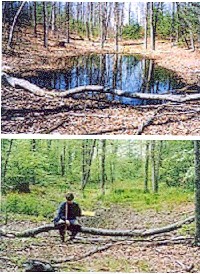
Same Vernal Pond Over 2 Seasons
|
By Kate Brandes, Environmental Scientist, Wildlands Conservancy
Water resources in our area range from streams and rivers to ponds and wetlands of all sizes. In the spring, vernal pools are one of the most unusual and interesting water resources.
Vernal pools are temporary pondings of snow melt and spring rain that collect in depressions throughout the forest (hence the name “vernal,” which is derived from the Latin word for spring). In our area, these pools are usually in woodlands and generally dry up in the summer. The trees that surround the pools are essential for shading the water and reducing evaporation. Forest vegetation controls silt runoff into the pools, which could otherwise be harmful to the breeding activities that occur within the pools.
The pools serve as breeding grounds primarily for amphibians – some, such as wood frogs and mole salamanders, breed nowhere else. In the first mild days of spring, sometimes as early as late February or early March, small, brown frogs with black masks, called wood frogs, seek out vernal pools to mate. Wood frogs don’t croak, but rather quack like a duck. Hundreds of wood frogs may seem to converge on a vernal pool overnight. Wood frogs are unusual among amphibians in that they conduct their rituals of courtship and mating in broad daylight
Mole salamanders (which include the spotted, Jefferson, and marbled salamanders) get their names from spending much of their lives in burrows on the forest floor. The spotted mole salamander is the most widespread and common around this area. It averages six to eight inches long; it is blue-black with a dozen or more large, lemon-yellow-to-orange spots on its back. Although they hide for most of the year, in the spring, on certain rainy nights, the spotted salamanders make their way to the same vernal pool from which they came. “Some ponds attract hundreds, even thousands, of salamanders, and they stream to water like commuters into a train station.” The salamanders return to the forest floor in a matter of a few days. The eggs produce larvae which must develop into adults and begin their lives as terrestrial animals before the pools dry.
Fairy shrimp or “sea monkeys” are small crustaceans that spend their entire lives (no more than a few weeks) in vernal pools. Eggs may hatch in the late winter or early spring, with adults growing to a size of about one inch. These shrimp drop eggs, which remain dormant in the sediment for months – even years – until the pond refills (DCNR, 2000).
Despite their importance to these unique species, not many people know much about vernal pools in Pennsylvania. Because they are visible generally only in the spring (unless it's a very wet year, like this one), they are easily overlooked and, therefore, easily destroyed. One can only guess how the spotted salamander might feel upon discovering that the wet woodlot it once migrated to season after season has now been paved. Volunteer programs are being developed, often using high school biology classes, to locate and map the pools. The first step in protecting these valuable habitats is generating a greater awareness of where they are.
This spring, I’m planning to embark on an adventure or two in which I will listen for the “quack” of the masked wood frogs to lead me to some local vernal pools. I hope that if I check often enough, I'll catch at least a glimpse of fairy shrimp and spotted salamanders. What could be a more fun and exciting springtime venture?
For more information visit the Vernal Pool Association and read a special article in Keystone Wildnotes from the Wild Resources Conservation Fund on the creatures inhabiting vernal ponds.
|